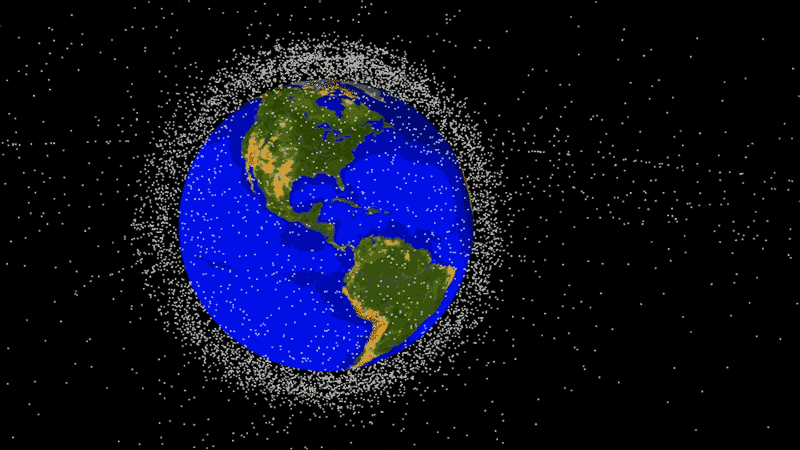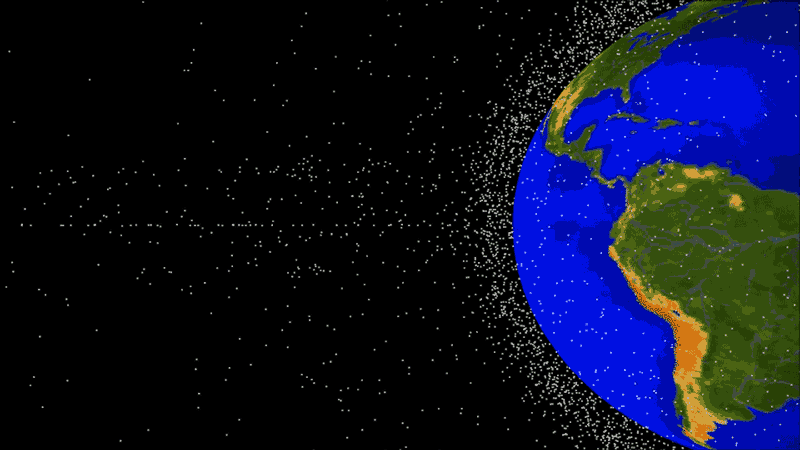The space junk crisis in Space Sweepers is already here

Jo Sung-Hee’s new sci-fi adventure movie Space Sweepers is a lot of things—a darkly comedic space western; a traumatized ex-soldier’s redemption story; a scathing criticism of billionaire space moguls—but beneath these many competing storylines is a warning about how capitalism is destroying the environment. Unlike most science fiction with a clear ecological message, though, Space Sweepers doesn’t limit its focus to Earth itself. Instead, the film highlights the disastrous consequences of treating Earth’s orbit like a giant garbage dump, something humanity is already doing.
In Space Sweepers, the year is 2092, Earth is barely habitable anymore, and the rich have fled to an orbital space habitat run by mega-corporation UTS. But escaping Earth’s gravity well didn’t free the wealthy of environmental woes. After decades of unfettered space development, there are millions of pieces of trash circling the Earth at rip-roaring speeds and threatening to destroy key infrastructure, like the solar panels that keep the UTS space habitat livable. In order to manage the problem, UTS offers bounties on particularly dangerous pieces of garbage, which crews of people risk their lives attempting to collect using cabled harpoons and giant, robotic claws.
Chock full of sci-fi ideas from space elevators to advanced nanotechnology, the Space Sweepers universe, while dystopian, also has a lavishly futuristic feel. But the central issue of space junk is no future crisis at all.

Since the start of the space age, rocket fragments, spent satellites, and small bits of debris have been accumulating in Earth’s cosmic backyard at an exponential rate. Today, NASA estimates there are more than 8,000 metric tons of trash whizzing about our planet, including some 26,000 pieces larger than a softball and more than half a million fragments larger than a marble. Tens of millions more flecks of trash are so small they can’t be tracked. And with no international laws preventing nations from producing more of it, the space junk problem continues to grow.
More than a cosmic eyesore, this trash is incredibly dangerous. Orbiting Earth at speeds of up to 17,500 miles per hour, even a relatively small piece of space junk can strike a satellite or spacecraft with the force of a grenade. And when our trash collides with stuff we’re still using, the result is more trash: When a defunct Russian satellite smashed into an Iridium commercial satellite in 2009, the collision added more than 2,000 pieces of trackable debris to the space junk inventory. Scientists’ biggest fear is that space junk collisions will eventually start a chain reaction, generating more and more pieces of trash and eventually rendering certain regions of orbit unusable.
“It might get to the point where we have to stop doing certain missions because it's just too hazardous or expensive, or move them to different orbits where they don't perform as well,” Brian Weeden, the Director of Program Planning at the Secure World Foundation, told The Science of Fiction. (The Secure World Foundation is an organization that advocates for the sustainable use of space environments.)
To prevent space from becoming too dangerous to use, we’re going to have to start cleaning it up. Scientists have proposed plenty of ideas for how to do so, including using CubeSat-sized spacecraft to grab and de-orbit large pieces of junk, or firing lasers from the ground to flick smaller pieces of debris out of harm’s way. Some of the most advanced ideas are similar to the tech on display in Space Sweepers.
In 2019, the University of Surrey-led RemoveDEBRIS mission fired a miniature harpoon at a piece of a satellite panel, successfully demonstrating that space junk can be skewered. In 2025, Swiss startup ClearSpace, in partnership with the European Space Agency, will launch a claw crane-like contraption to capture a derelict Vespa adapter for a Vega rocket. The two will then drop into Earth’s atmosphere and burn up in what is being described as the world’s first “active debris removal” mission.
Weeden says that a big challenge with either the harpoon or claw approach is that in the real world, space debris is spinning on multiple axes “and the removal spacecraft would have to match that spin precisely.”
“Another challenge is that the debris object may be structurally unsound or have remaining fuel, so puncturing it with a harpoon or grabbing it with a claw might cause it to rupture or shatter, creating a bigger problem,” Weeden said. This is why scientists are also considering more passive cleanup techniques, like nets, which were demonstrated in another recent RemoveDEBRIS experiment.
While the techniques used by the film’s titular space sweepers feel plausible given the current direction of space junk removal technology, a big difference, Weeden says, is that future cleanup missions are likely to be entirely robotic for the simple reason that crewed missions are “far more expensive and challenging than creating robots.”
And while Space Sweepers envisions a Wild West of ragtag crews chasing garbage bounties, in reality we’re a long way off from a commercial market for space debris. Most of the junk that’s in orbit today was created by governments, and until the costs of space cleanup come down significantly, governments will probably have to finance its removal. (The European Space Agency is ponying up a cool 104 million U.S. dollars for ClearSpace’s upcoming space trash removal services.)

Even if a company found private buyers willing to pay enough to cover the costs of salvaging space debris, there’s a potentially big legal obstacle: Countries that put stuff into orbit retain jurisdiction over it for as long as it’s up there. “You can't just go up and grab any object,” Weeden said. “[Y]ou need to first figure out who owns it and that may not be possible for the smaller pieces we haven't been tracking.”
Another challenge for would-be space junk scavengers is that most of what’s up in orbit has been subjected to harsh temperatures and radiation for years to decades, potentially limiting our ability to repurpose or recycle it.
Legal and technical obstacles aside, the space junk cleanup market appears to be on its way. A 2019 report by Northern Sky Research projected that by 2028, in orbit satellite services companies will have generated 4.5 billion in cumulative revenue. While services to extend the life of operational satellites accounts for the largest share of that revenue, de-orbiting services (aka taking out the trash) will become more important as more space agencies and companies launch satellites into low Earth orbit.
Hopefully, the technology for cleaning up space junk continues to mature and we see some sound policymaking that stems the tide of trash while allowing a robust salvage market to develop. Otherwise, we may well end up in a Space Sweepers-esque situation, where governments and corporations continue to pollute Earth’s orbit until the situation becomes untenable, and cleaning it up becomes a race to the bottom.
Top image: Netflix. GIFs made from “Debris in Motion” a NASA Orbital Debris Program Office animation representing actual pieces of space debris catalogued in orbit.